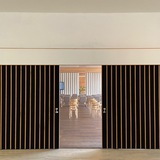Как мы уже писали, Фрэнсис Бэкон начинал с оформления интерьеров, и, хоть впоследствии «слово “оформительство” было одним из самых грубых в его лексиконе», как рассказывает друг и биограф Бэкона Майкл Пеппиатт, именно короткий период работы интерьерным дизайнером на рубеже 1920-1930-х гг. и подготовил его к живописи. Помимо проектов интерьеров и мебели Бэкон в этот период создал еще и ряд интересных ковров: если рассмотреть первые сохранившиеся живописные работы художника, то станет очевидно, что в эволюции его творчества ковры (и как минимум одна ширма) были «переходной формой» или даже «недостающим звеном», учитывая, что Бэкон уничтожил многие свои ранние произведения. Но если мебель Бэкона была явно вдохновлена Баухаусом, то ковры обнаруживают влияние Пикассо, Жана Люрса, Фернана Леже и других авангардистов, в тот период возрождавших французское ковроткачество с легкой руки Мари Кюттоли.
В 1933 г. Бэкон распрощается с дизайном и всецело посвятит себя живописи. Тем не менее, дизайнерский опыт в дальнейшем будет эхом отзываться во многих его работах, а наряду с кистями Бэкон будет использовать рейсшину, которая останется в его мастерской до конца его дней.
———
As we have already mentioned, Francis Bacon began his career as an interior designer, and although, as his friend and biographer Michael Peppiatt recounts, “Decoration was one of the foulest words in his vocabulary after that," it was this brief period in interior design in the late 1920s and early 1930s that set the stage for his subsequent career in painting. In addition to interior and furniture designs, Bacon also created a series of remarkable rugs. If one is to explore the artist's earliest surviving paintings, it becomes clear that rugs (and at least one screen) were a "transitional form" in the evolution of his work (we may even stretch this metaphor further and refer to this oeuvre as a "missing link", considering that Bacon destroyed many of his early works). While his furniture was clearly inspired by Bauhaus, his carpets reveal the influence of Picasso, Jean Lurçat, Fernand Léger, and other avant-garde artists who were reviving French tapestry-making under the guidance of Marie Cuttoli at the time.
In 1933, Bacon would abandon his career in design and devote himself entirely to painting. That said, his design experience would later echo in many of his works. He would even paint using his T-square, a tool that would remain in his studio for the rest of his life.
(photos: The Estate of Francis Bacon, xennex via wikiart.org, selvedge.org, DCMS/PA via theguardian.com,sothebys.com, vam.ac.uk, artchive.com, architectureforlondon.com, seattleartistleague.com, fb-akermariano.blogspot.com, worldartfoundations.com, Adagp via apollo-magazine.com, christies.com)
В 1933 г. Бэкон распрощается с дизайном и всецело посвятит себя живописи. Тем не менее, дизайнерский опыт в дальнейшем будет эхом отзываться во многих его работах, а наряду с кистями Бэкон будет использовать рейсшину, которая останется в его мастерской до конца его дней.
———
As we have already mentioned, Francis Bacon began his career as an interior designer, and although, as his friend and biographer Michael Peppiatt recounts, “Decoration was one of the foulest words in his vocabulary after that," it was this brief period in interior design in the late 1920s and early 1930s that set the stage for his subsequent career in painting. In addition to interior and furniture designs, Bacon also created a series of remarkable rugs. If one is to explore the artist's earliest surviving paintings, it becomes clear that rugs (and at least one screen) were a "transitional form" in the evolution of his work (we may even stretch this metaphor further and refer to this oeuvre as a "missing link", considering that Bacon destroyed many of his early works). While his furniture was clearly inspired by Bauhaus, his carpets reveal the influence of Picasso, Jean Lurçat, Fernand Léger, and other avant-garde artists who were reviving French tapestry-making under the guidance of Marie Cuttoli at the time.
In 1933, Bacon would abandon his career in design and devote himself entirely to painting. That said, his design experience would later echo in many of his works. He would even paint using his T-square, a tool that would remain in his studio for the rest of his life.
(photos: The Estate of Francis Bacon, xennex via wikiart.org, selvedge.org, DCMS/PA via theguardian.com,sothebys.com, vam.ac.uk, artchive.com, architectureforlondon.com, seattleartistleague.com, fb-akermariano.blogspot.com, worldartfoundations.com, Adagp via apollo-magazine.com, christies.com)
